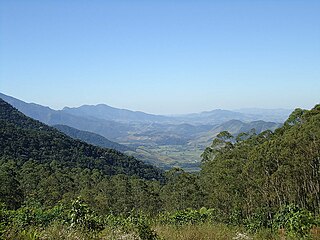
Quixeramobim is a municipality in central State of Ceará, northeastern Brazil. It has a population of about 72,000. The local biome is caatinga hiperxerófila.

Jari Ecological Station is an ecological station in Brazil, located in the states of Amapá and Pará, created in 1984.

The Northeast Ecological Corridor Nature Reserve (NECNR) refers to an area designated as a protected Nature Reserve located on the northeast coast of Puerto Rico, between the municipalities of Luquillo and Fajardo. Specifically, the lands that comprise the NEC are located between Luquillo's town square to the west and Seven Seas Beach to the east, being delineated by PR Route # 3 to its south and the Atlantic Ocean to its north. It was decreed as a protected area by former Puerto Rico Governor Aníbal S. Acevedo-Vilá in April 2008, a decision reversed by Governor Luis G. Fortuño-Burset in October 2009, although he later passed a law in June 2012 re-designated as nature reserve two-thirds of its lands, after intense lobbying and public pressure. Later, in 2013, Governor Alejandro García-Padilla signed a law declaring all lands within the NEC a nature reserve. The area comprises 2,969.64 acres, which include such diverse habitats as forests, wetlands, beaches, coral communities, and a sporadically bioluminescent lagoon. The Corridor is also home to 866 species of flora and fauna, of which 54 are considered critical elements, meaning rare, threatened, endangered and endemic species classified by the Puerto Rico Department of Natural and Environmental Resources (DNER), some even designated as critically endangered by the International Union for Conservation of Nature and Natural Resources (IUCN). These include, among others, federally endangered species such as the plain pigeon, the snowy plover, the Puerto Rican boa, the hawksbill sea turtle and the West Indian manatee. The beaches along the NEC, which are 8.74 kilometers long are important nesting grounds for the leatherback sea turtle, which starts its nesting season around April each year.

An area of relevant ecological interest is a type of protected area of Brazil with unusual natural features and with little or no human occupation.

The Ilha do Mel Ecological Station is an ecological station in the state of Paraná, Brazil.

The Serra do Mar Ecological Corridor is a large collection of protected areas in the states of Rio de Janeiro, Minas Gerais, São Paulo and Paraná in southern Brazil that form an ecological corridor connecting areas of Atlantic Forest.

The Bocaina Mosaic is a protected area mosaic on the border between Rio de Janeiro and São Paulo, Brazil. It provides coordinated management for a group of 10 federal, state and municipal conservation units covering an area of Atlantic Forest along the coast and up the slopes of the Bocaina plateau.

The Mantiqueira Mosaic is a protected area mosaic that contains conservation units in the states of Rio de Janeiro, São Paulo and Minas Gerais, Brazil. The conservation units are of different types and are managed at the federal, state or municipal level. The mosaic provides a level of integrated and coordinated management.

The Central Amazon Ecological Corridor is an ecological corridor in the state of Amazonas, Brazil, that connects a number of conservation units in the Amazon rainforest. The objective is to maintain genetic connectivity between the protected areas without penalizing the local people, where possible using participatory planning that involves all affected actors.

The Javari-Buriti Area of Relevant Ecological Interest is an area of relevant ecological interest in the state of Amazonas, Brazil.

The Central Atlantic Forest Ecological Corridor (Portuguese: Corredor Central da Mata Atlântica is an ecological corridor in the states of Espírito Santo and Bahia, Brazil. It promotes improvements to connectivity between fragments of Atlantic Forest in the region with the goal of maintaining genetic health among flora and fauna.

The Wenceslau Guimarães Ecological Station is an ecological station in the state of Bahia, Brazil.

The Northern Amazon Ecological Corridor is a proposed ecological corridor connecting conservation units and indigenous territories in the north of the Amazon rainforest of Brazil.

The South Amazon Ecological Corridor is a proposed ecological corridor connecting conservation units and indigenous territories in the southeast of the Amazon rainforest of Brazil.

The Western Amazon Ecological Corridor is a proposed ecological corridor connecting conservation units and indigenous territories in the southwest of the Amazon rainforest of Brazil.

The South Amazon Ecotones Ecological Corridor is a proposed ecological corridor connecting conservation units and indigenous territories that form an ecotone, or transition between the south of the Amazon rainforest and the north of the cerrado of Brazil.

The Caatinga Ecological Corridor is an ecological corridor in the caatinga biome of northeast Brazil.

The Capivara-Confusões Ecological Corridor is an ecological corridor in the caatinga biome of the state of Piauí in northeast Brazil.

The Santa Maria Ecological Corridor is an ecological corridor in the state of Paraná, Brazil.













